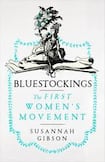
In the early 19th century the future Irish novelist William Carleton was hired by a Louth farmer called Piers Murphy and his wife to educate their children. In his memoirs Carleton writes that when he first met his pupils he wanted to burst out laughing – because all but one of the children were female (Mrs Murphy, Carleton writes, had been “educated in a nunnery”, and clearly had notions).
Carleton’s opinion that educating girls was a joke would have been commonly accepted in Europe at the time. But a few decades earlier, educated women attained a status that had never been witnessed and wouldn’t be seen again until the 20th century. Women like the aristocratic critic Elizabeth Montagu, the diarist Hester Thrale and the classicist Elizabeth Carter became famous in 18th century England not because of their beauty or their riches, but because of their wit and literary skill. Inspired by the salonnieres of Paris, Montagu and Thrale hosted their own salons where both men and women gathered to show off their wit and erudition.
In this engaging and elegantly written book (the Bluestockings would surely approve), Irish writer and Cambridge-based historian Susannah Gibson tells the stories of the women who showed the anglophone world that women could be men’s intellectual equals, and could also earn money from their literary work. This demonstration of independent female thought, Gibson convincingly argues, changed that world forever. The Bluestockings – jokingly self-named after the cheap worsted stockings worn not by a woman but by a male regular visitor to Montagu’s salons – “created a new sphere for women”.
While there is some exploration of the bigger picture, Gibson’s book focuses on a relatively small group of women, telling their stories to illustrate how they experienced and challenged everything from motherhood and friendship to love and independence. While at times it feels like the detailed focus on individuals is an opportunity for Gibson to cram in as much of her (thorough) research as possible, it can also be very effective. The deeply moving Motherhood chapter looks at the traumatic experiences of Hester Thrale, who gave birth to 12 children, most of whom died in childhood; it also shows how those Bluestockings who lost children were able to find solace in their friends and their intellectual work.
Throughout the book, Gibson reminds us that in most respects the Bluestockings were not radicals. Almost all came from upper middle or aristocratic backgrounds. Most were political and social conservatives, who were terrified of rocking the social boat. They were painfully aware that despite their public success, the wider world was ready to pounce on any supposed moral or social failings in intellectual women and use them as proof that learning made women depraved or – heaven forfend – unfeminine. When the widowed Thrale followed her heart and married a Catholic Italian singing teacher, most of her old friends abandoned her.
Gibson also shows that even those who can be described as progressive, such as the abolitionist Hannah More and the republican historian Catherine Macaulay, had blind spots. Macauley was anti-slavery, but when she finally witnessed the horrific system in action as a guest of George Washington at Mount Vernon, she left no written account of it and was, as Gibson says “remarkably quiet on the topic of her American friends’ participation in the trade”.
As for More, one of the most fascinating sections of the book explores her relationship with Ann Yearsley, the “milkwoman poet”. More discovered Yearsley because she collected More’s kitchen slops to feed her pigs. She championed Yearsley’s poetry, which became hugely successful. But she also tried to control the poet’s finances, believing (based on nothing but the fact that Yearsley was working class) that she was incapable of managing her own money. Despite all odds, Yearsley was able to break away and continue her writing career, taking care of her family with her earnings. As Gibson says: “she forced people to think differently about working-class women”.
Gibson astutely points out that the Bluestockings “gently pushed back against the limits imposed upon them, they (even more gently) ridiculed the system, but they could not envisage a world without it”. And for a while it seemed that they had changed nothing; by the early 19th century, the Bluestockings were figures of fun. But by the end of that century, things were changing.
Today the idea that women are capable of rational thought and deserve an education is taken for granted, in this part of the world at least. The Mrs Murphy who hired a sceptical William Carleton to teach her daughters was my multiple-great grandmother. And now here I am, writing about educated ladies. As Gibson says, the Bluestockings’ “ideas have been sewn into the very fabric of our society. Theirs is a call that echoes down the centuries.”













